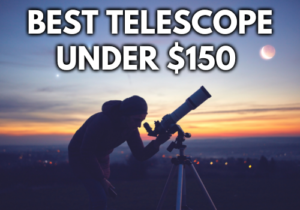Best Telescope To See Jupiter & Its Moons 2025; Reviews
Disclosure: This post contains affiliate links and I may earn a small commission (at no extra cost to you) if you click through and make a purchase. Thanks in advance – I really appreciate it!
Here in this “Best Telescope To See Jupiter & Its Moons” article we’ve rounded up 9 of the best telescopes of various types, specifications, and budget perfectly suitable to view Jupiter’s Moons. Below, you’ll find in-depth reviews of each, as well as an elaborate buying guide to help you pick out the one that suits you the most.
COMPARISON TABLE
| Image | Title | Best For | Features | Price | Buy |
|---|---|---|---|---|---|
Top Top
Top
Top
Top Top
Top
Top
Top | Celestron - AstroMaster 114EQ | Best For Beginners | Type: Newtonian reflector, Aperture: 114mm (4.49″), Focal length: 1000mm, Focal Ratio: f/9 | See on Amazon | |
 Top
Top
Top
Top
Top
Top | Celestron - PowerSeeker 70EQ | Best budget Pick | Aperture: 70mm (2.8″), Focal length: 700mm, Focal Ratio: f/10 | See on Amazon | |
 Top
Top
Top
Top
Top
Top | Orion StarBlast II 4.5 Equatorial Reflector | Best Intermediate Pick | Type: Reflector, Aperture: 114mm (4.5″), Focal length: 450mm, Focal Ratio: f/4 | See on Amazon | |
 Top
Top
Top
Top
Top
Top | Celestron - NexStar 6SE | Best Computerized | Type: Schmidt-Cassegrain, Aperture: 150mm (5.9″), Focal length: 1500mm, Focal Ratio: f/10 | See on Amazon | |
 Top
Top
Top
Top
Top
Top | Orion 09007 SpaceProbe 130ST | Best Reflector | Type: Reflector, Aperture: 130 mm(5.1″), Focal length: 650mm, Focal Ratio: f/5 | See on Amazon | |
 Top
Top
Top
Top
Top
Top | Celestron - AstroMaster 130EQ | Best For Home | Type: Reflector, Aperture: 130 mm(5.1″), Focal length: 650mm, Focal Ratio: f/5 | See on Amazon | |
 Top
Top
Top
Top
Top
Top | Celestron - PowerSeeker 127EQ | Best Portable | Type: Reflector, Aperture: 127 mm(5″), Focal length: 1000mm, Focal Ratio: f/8 | See on Amazon | |
 Top
Top
Top
Top
Top
Top | Sky-Watcher EvoStar 100 APO Doublet Refractor | Best For Astrophotography | Type: Apochromatic Refractor, Aperture: 100 mm(3.9″), Focal length: 900mm, Focal Ratio: f/9 | See on Amazon | |
 Top
Top
Top
Top
Top
Top | Celestron - NexStar 127SLT | Best For Jupiter's Moons | Type: Maksutov-Cassegrain, Aperture: 127mm (5″), Focal length: 1500mm, Focal Ratio: f/12 | See on Amazon |
Product prices and availability are accurate as of the date/time indicated and are subject to change. Any price and availability information displayed on [relevant Amazon Site(s), as applicable] at the time of purchase will apply to the purchase of this product.
Prices pulled from the Amazon Product Advertising API on: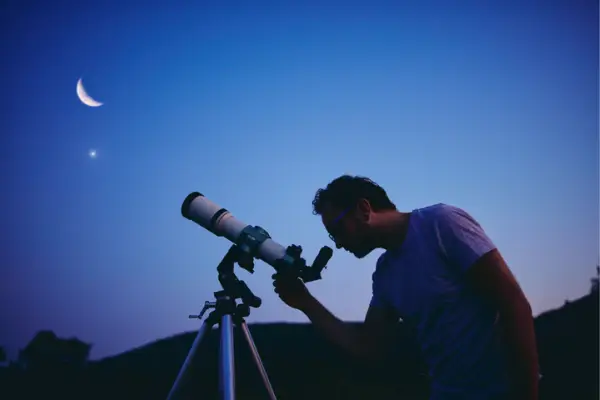
When is the best time to observe Jupiter in a telescope?
At the beginning of every January, Jupiter is usually best observed at the end of the night and before the sun rises. Over the following months, the planet will gradually show up earlier and earlier in the night sky. In the northern hemisphere, you should be able to see Jupiter in a telescope from 11 pm.
The best time to view Jupiter through your home telescope is when it is at opposition from the sun in the sky (from our point of view). This means that Earth & Jupiter’s orbit briefly “sync” up on the same side of the sun.
When this happens, Earth is positioned directly between Jupiter and the sun, which gives amateur astronomers the perfect angle to observe the planet. Thanks to its proximity to our planet, Jupiter will appear a lot brighter and will allow for great seeing.
Best Telescope To See Jupiter
With so many models with so many features available today, it can be a tedious task to find the best telescope to see Jupiter. We have analyzed the main features ( aperture, focal length, ratio, portability, affordability etc.) that make a good telescope for viewing planets that you can use to enjoy the night sky and fulfill your love for astronomy.
Best For Beginners
Celestron – AstroMaster 114EQ
- Type: Newtonian reflector
- Aperture: 114mm (4.49″)
- Focal length: 1000mm
- Focal Ratio: f/9
- Mount: Equatorial
- Eyepiece: 20mm, 10mm
- Magnification: 50x, 100x
- Weight: 17 lbs (7.71 kg)
- Our Rating: 8.2/10
Prices pulled from the Amazon Product Advertising API on:
Product prices and availability are accurate as of the date/time indicated and are subject to change. Any price and availability information displayed on [relevant Amazon Site(s), as applicable] at the time of purchase will apply to the purchase of this product.
The Celestron AstroMaster 114 EQ reflector telescope is a great beginner telescope for an adult or a teenager. It’s 4.5” mirror will provide clear and bright images of the Moon, the planets, and dozens of deep-sky objects like the Orion Nebula, the Andromeda Galaxy, the great star cluster in Hercules, and much more.
It features all-glass optical elements, smooth operating steel tripod mountings with manual motion controls, and coated optics for enhanced image brightness and clarity. The quick-release, no-tool dovetail attachment makes setup a breeze. It’s all anchored by a rugged, pre-assembled tripod with 1.25-inch steel tube legs, providing a rigid and stable platform.
The scope is outfitted with a 1.25 rack-and-pinion focuser and two eyepieces (20mm & 10mm) to get new users started, and an unmagnified red-dot finder to help set-up, align and navigate easier.
The Celestron AstroMaster 114 EQ reflector telescope comes with a 4.5” mirror as its light-gathering source, and with optics that large, an amateur astronomer can see millions of light years into the Universe.
With the telescope, you will also receive a wonderful piece of software with the Celestron AstroMaster 114 EQ reflector telescope.
TheSkyX First Light Edition planetarium software can be loaded on your computer to help assist you with an observing plan. It has a 10,000 object database and enhanced images of celestial objects
Pros:
- Easy to setup and use
- Versatile telescope
- Excellent optics for the price
- Sturdy, retractable tripod
- Portable
Cons:
- Modest focuser
- Not good for astrophotography
Best Budget Telescope
Celestron – PowerSeeker 70EQ
- Aperture: 70mm (2.8″)
- Focal length: 700mm
- Focal Ratio: f/10
- Mount: Equatorial
- Eyepiece: 20mm, 4mm
- Magnification: 35x, 175x
- Weight: 13.9 lbs.(6.3 kg)
- Our Rating: 9/10
Prices pulled from the Amazon Product Advertising API on:
Product prices and availability are accurate as of the date/time indicated and are subject to change. Any price and availability information displayed on [relevant Amazon Site(s), as applicable] at the time of purchase will apply to the purchase of this product.
The 70EQ Power Seeker is a refractor telescope with a 70mm aperture and a focal length of 700mm. Its low price combined with excellent optics, easy assembly, clear instructions, included eyepieces and other features that make it easy to use even for beginners, make it an excellent choice for anyone wanting to learn more about the nighttime sky.
At f/10, there is some chromatic aberration but nothing significant enough to ruin high-power views with this telescope. The optical quality of the Powerseeker 70 is quite good.
The scope’s focuser is a 1.25” rack-and-pinion made mostly of plastic. The focuser even includes a tension adjustment knob, should you find the focuser to be too loose or too tight.
Since Celestron 21037 PowerSeeker 70EQ telescope is a family-friendly scope, it is very easy to set up and use as it needs no extra tools. The instructions manual clearly describes every setup step, giving clear information on each of the telescope’s parts and uses.
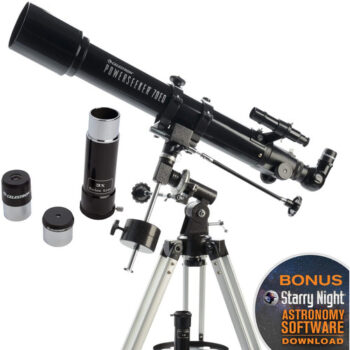
With an aperture of 70 mm (2.76“) and a focal length of 700 mm (28”), the Celestron Power Seeker telescope allows stargazers to see the Moon, Jupiter, Saturn and other celestial wonders with ease.
The 3x Barlow lens manages to triple the magnifying power of all eyepieces, while the 1.25″ Erect Image Diagonal makes the telescope ideal for both astronomical and terrestrial use.
The telescope includes fully coated optics, meaning that at least one lens in the telescope has been coated with multiple layers of substances designed to capture and focus the light that goes through the lens.
The equatorial mount supplied with the 70EQ is actually a good match for it. The motions are reasonably smooth, the mount’s extruded aluminum legs are quite steady with such a lightweight tube. Furthermore, the whole setup is pretty light at about 14 pounds.
The 70EQ PowerSeeker is the best amateur telescope to photograph Jupiter as it comes with a camera attachment that allows the user to take photographs of the objects being viewed.
Pros:
- Family-friendly, easy to setup and use
- Coated glass, decent optical components
- EQ mount with slow motion controls
- Budget option refractor telescope for astrophotography
- High and low power eyepieces
- Ideal for both terrestrial and celestial viewing
Cons:
- Not suitable for professional use
- Most components are built with plastic
Related
Best Intermediate Telescope
Orion StarBlast II
- Type: Reflector
- Aperture: 114mm (4.5″)
- Focal length: 450mm
- Focal Ratio: f/4
- Mount: Equatorial
- Eyepiece: 25mm, 10mm
- Magnification: 18x, 45x
- Weight: 20.7 lbs.(9.4 kg)
- Our Rating: 9.4/10
Prices pulled from the Amazon Product Advertising API on:
Product prices and availability are accurate as of the date/time indicated and are subject to change. Any price and availability information displayed on [relevant Amazon Site(s), as applicable] at the time of purchase will apply to the purchase of this product.
The StarBlast II 4.5 EQ is one of the best reflector telescope for adults which also the whole family can enjoy, thanks to its great optics, convenient portability, and easy-to-use operation.
Views of everything from the Moon and planets to distant objects like star clusters and galaxies appear bright and clear through this amazing telescope.
It works amazingly well with the included Expanse telescope eyepieces which yield a very wide 66° apparent field of view that allows you to see distant deep space objects as well as moon and planets like Jupiter & Saturn.
The included 25mm Sirius Plossl eyepiece provides 18x power magnification, while the 10mm Sirius Plossl eyepiece bumps up the power to 45x magnification. The 25mm is a great eyepiece to begin observing sessions with, since it provides a large window of night sky for you to view.
The telescope’s combination of short 450mm focal length and sizable 4.5″ aperture means the StarBlast II 4.5 EQ will provide brighter views at any magnification compared to longer focal length telescopes, which makes it easier for everyone, and especially beginners, to locate interesting sights in the night sky.
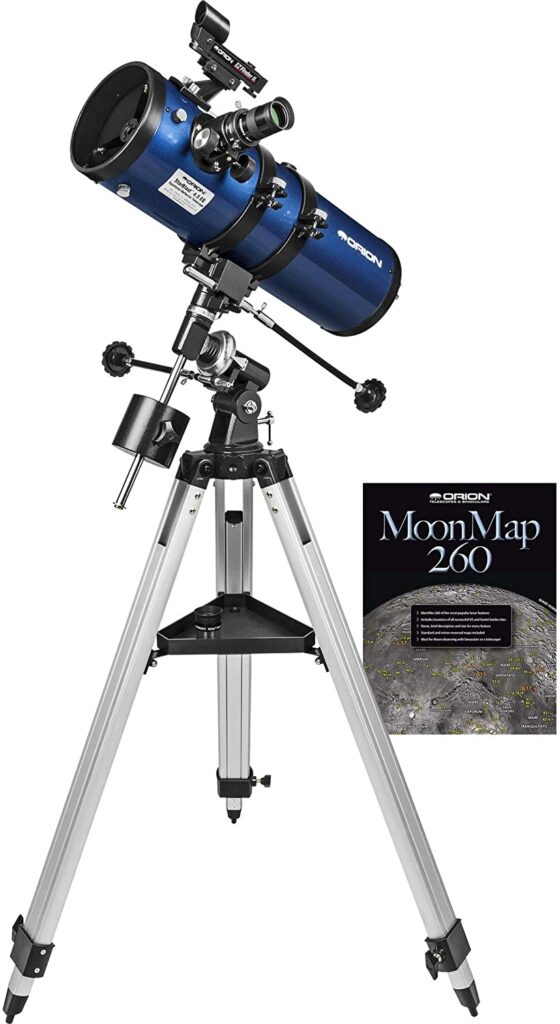
The StarBlast II sits inside two felt-lined tube rings that bolt onto the EQ-1 mount’s top plate – larger/more expensive equatorials use a Vixen dovetail and saddle which is slightly more convenient, but the simple system used with the StarBlast II works just fine.
Setting up and using the EQ-1 is pretty easy – just level the tripod, put the mount/scope together, balance the scope on both axes, and roughly line up the mount’s polar axis with Polaris.
Thanks to this design, it’s easy for anyone in the family to manually track a celestial object using slow-motion control cables. You can even add an optional electronic motor drive (sold separately) to the EQ-1 equatorial mount so it can track objects automatically once you’ve centered the object in the telescope eyepiece.
Pros:
- Wide field of view
- Lightweight and portable
- Easy to use
- Compatible with high-quality accessories
- Suitable for astrophotography
- Great for beginners and families with children
- Sturdy equatorial mount
Cons:
- No finder scope
- Not suitable for use in daylight
Best Computerized Telescope
Celestron – NexStar 6SE
- Type: Schmidt-Cassegrain
- Aperture: 150mm (5.9″)
- Focal length: 1500mm
- Focal Ratio: f/10
- Mount: Computerized – Alt-Azimuth
- Eyepiece: 25mm
- Magnification: 60x
- Weight: 30 lbs. (13.6 kg)
- Our Rating: 9.6/10
Prices pulled from the Amazon Product Advertising API on:
Product prices and availability are accurate as of the date/time indicated and are subject to change. Any price and availability information displayed on [relevant Amazon Site(s), as applicable] at the time of purchase will apply to the purchase of this product.
The NexStar 6SE offers consumers the proven quality of the Celestron brand in a compact, portable, and technologically advanced telescope.
The scope’s 6-inch aperture, portable design, fully functional computer, and extensive database, among other features, make it easy to use, easy to transport, and easy to enjoy regardless of experience level. The NexStar 6SE is quite evidently the best computerized telescope for amateur astronomers.
The NexStar 6SE is a 6-inch Schmidt Cassegrain Telescope, which has an actual aperture of 150 mm and focal length of 1,500 mm, giving it a focal ratio of f/10. The OTA comes on a Vixen-style dovetail bar, which fits into the dovetail saddle on the mount.
The telescope also comes with a 1.25” prism diagonal, 25 mm Plossl eyepiece (providing 60x when used with the 6SE) and Celestron’s StarPointer, which is a zero-power red-dot-style finder.
The Celestron NexStar 6 SE is a solid and sturdy telescope, perfect for home use and astrophotogaphy.
The Celestron NexStar 6 SE is easy to align with Celestron’s SkyAlign Go-To Alignment system.
On average it takes a new telescope user approximately 5 minutes to do a full sky alignment with the NexStar 6 SE.
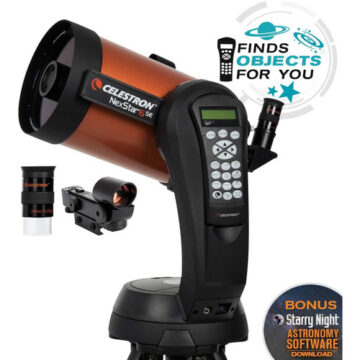
Once aligned, the telescope is incredibly easy to operate. The hand controller on the NexStar 6SE allows you to move the telescope at your discretion. If you are looking for a telescope that can help you transition from beginner to a bit advanced astronomer without much guidance then look no further than the NexStar 6SE.
The NexStar 6SE’s hand controller offers a tour of the night sky and easily allows you to locate planets, galaxies or any of the 40,000 celestial objects in its database.
To power the 6SE you have two options, 8x AA batteries or 12v DC power supply. The 8x AA batteries would last you about 3 hours (included alignment of finderscope and general terrestrial viewing and the 40 minute observation session).
You can download all the available upgrades from Celestron’s website. In this way, you can keep your telescope up to date, and you can even control your telescope via computer.
The 6SE makes a good choice for consumers living in areas with light-pollution who are looking for clarity and accuracy in their viewing experience.
Given its capabilities, this telescope is quite difficult to outgrow — it can be used as an observer’s main instrument or even as an add-on to existing kit, providing the astronomer with the flexibility of a quicker, fuss-free skywatching experience over more complex setups.
The NexStar 6SE is easy to accessorize with additional eyepieces, red dot finders, filters and star diagonals, which is essential for bettering your views of solar system and deep-sky objects.
Pros:
- Perfect for amateur astronomers since the automatic GoTo mount with a database of over 40,000 celestial objects
- Highly portable – fits easily in the back of a normal car
- Can be used with a camera
- 2-year limited warranty
Cons:
- Drains batteries quickly — AC power cord required
- Not as portable as similar GoTo telescopes
Best Reflector
Orion 09007 SpaceProbe 130ST
- Type: Reflector
- Aperture: 130 mm(5.1″)
- Focal length: 650mm
- Focal Ratio: f/5
- Mount: Equatorial
- Eyepiece: 25mm, 10mm
- Magnification: 26x, 65x
- Weight: 24.2 lbs.(11 kg)
- Our Rating: 9/10
Prices pulled from the Amazon Product Advertising API on:
Product prices and availability are accurate as of the date/time indicated and are subject to change. Any price and availability information displayed on [relevant Amazon Site(s), as applicable] at the time of purchase will apply to the purchase of this product.
The Orion SpaceProbe 130ST Newtonian Reflector is an excellent and one of the best reflector telescope to see Jupiter. It is well-suited for both beginners as well as intermediate stargazers.
The SpaceProbe 130ST is a 130mm f/5 Newtonian reflector telescope.
This 5.1″ aperture reflector telescope gathers an ample amount of light for great views of the planets and Moon, as well as brighter galaxies, nebulas, and star clusters
The telescope also comes with tools to help you assemble the product, and two eyepieces: 10mm for 65x, and a 25mm for 26x magnification, respectively.
The quick set-up and ease of use makes the SpaceProbe 130ST EQ a very versatile telescope which the whole family can enjoy.
This Orion space probe telescope also boasts a short 24″ long optical tube design which enhances its portability, while the 130mm optical diameter, and the 650mm focal length are in perfect balance with the f/5.0 focal ratio.
In addition, it possesses design features, such as a parabolic mirror and a specially designed holder for the secondary mirror, that focus the light captured by the aperture and use it to sharpen the images produced by the scope, even with its shorter tube.
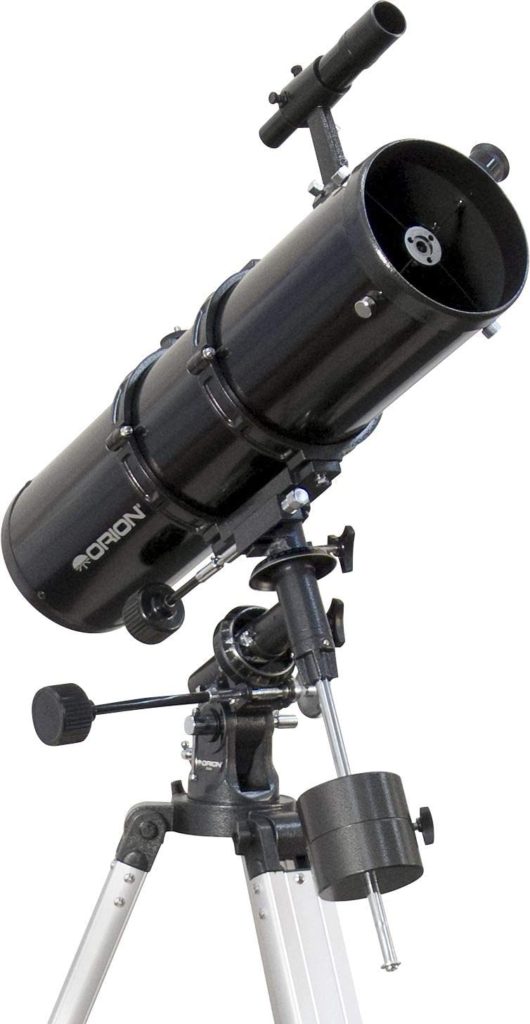
The included aluminium tripod is very sturdy, and also includes an accessory tray that can be very useful when you are outdoors in the dark and need a place to organize your accessories neatly.
The equatorial mount is perfectly built and allows manual slow-motion tracking of celestial objects as they move across the sky.
The mount can also be upgraded at a later time to a motorized option that tracks objects automatically, so that’s a nice option to have and definitely a plus if you are using the Orion SpaceProbe 130ST for astrophotography.
Just like many other similar products, the Orion 09007 also comes with Orion’s Starry Night software, which is very useful for beginners, and has the added benefit of alerting the user of upcoming celestial events.
Short 24″ long optical tube design for easy portability and fast f/5 focal ratio for pleasing wide-field performance makes the SpaceProbe 130ST EQ a very versatile telescope the whole family can enjoy
Pros:
- Nice set of accessories
- Can be upgraded to have motorized tracking
- Comes with an Equatorial mount and a versatile tripod
- Easy to assemble and transport
Cons:
- Plastic focuser and mount parts
- Somewhat confusing instructions
Best Home Telescope
Celestron – AstroMaster 130EQ
- Type: Reflector
- Aperture: 130 mm(5.1″)
- Focal length: 650mm
- Focal Ratio: f/5
- Mount: Equatorial
- Eyepiece: 20mm, 10mm
- Magnification: 32.5x, 65x
- Weight: 28.0 lbs.(12.7 kg)
- Our Rating: 9.2/10
Prices pulled from the Amazon Product Advertising API on:
Product prices and availability are accurate as of the date/time indicated and are subject to change. Any price and availability information displayed on [relevant Amazon Site(s), as applicable] at the time of purchase will apply to the purchase of this product.
Designed for near and deep-sky observation with a fast focal ratio for astrophotography/imaging, Celestron‘s AstroMaster 130EQ 130mm f/5 Reflector Telescope features a 650mm focal length and an oversized parabolic mirror that produce detailed images of the Moon, clear views of the planets, and the ability to resolve distant objects such as nebulae and galaxies.
The telescope is fitted with a 1.25 rack-and-pinion focuser and two eyepieces to get new users started – a 10mm that yields 65x power and a 20mm for a 32.5x magnification.
The 20mm eyepiece integrates an erecting system to correct images horizontally and vertically to allow easy terrestrial use.
The AstroMaster 130EQ also features an unmagnified red-dot finder to help set-up, align and navigate easier.
Celestron’s AstroMaster 130EQ 130mm f/5 Reflector Telescope features a 650mm focal length and an oversized parabolic mirror that produce detailed images of the Moon, clear views of the planets, and the ability to resolve distant objects such as nebulae and galaxies.
The 130EQ comes on a lightweight German equatorial mount that works well enough for the 130 mm f/5 OTA, and it should work okay with a DSLR camera piggybacked on top.
Since it can get quite hard to keep the object in the view because of the Earth’s rotation, there is an upgrade for this mount to help you with that.
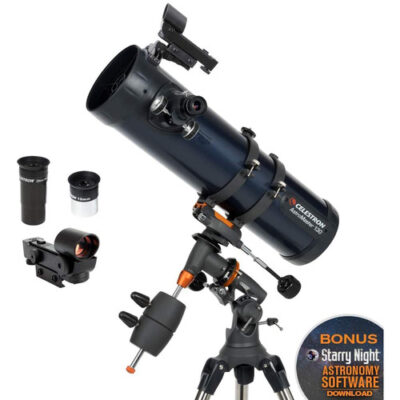
It is a simple clock motor which you turn on after you get the object in the view and it will track the object keeping it in the middle of the eyepiece.
It’s much easier to stargaze like this rather than twisting the knobs while looking through the eyepiece. The motor is not included but it can be bought separately.
The Celestron’s AstroMaster 130EQ is one of the best entry level telescopes for astrophotography as not only is it great for planetary viewing, with the moons of Jupiter and rings of Saturn being star attractions, but being a reflector telescope with a wide aperture, it could be one of the cheapest telescopes on offer that can decently display and photograph deep space objects.
At just 17 lbs total weight and thanks to its compact design, the Celestron AstroMaster 130 EQ is very portable. You can take it literally everywhere with you, unlike heavier and bulkier telescopes for professional use.
Pros:
- Very good optics
- Decently priced telescope
- Suitable for beginners as well as advanced users
- Clear crisp mirrors
Cons:
- Focuser is of limited usability
- No filters included
Best Portable Telescope
Celestron – PowerSeeker 127EQ
- Type: Reflector
- Aperture: 127 mm(5″)
- Focal length: 1000mm
- Focal Ratio: f/8
- Mount: German Equatorial
- Eyepiece: 20mm, 4mm
- Magnification: 50x, 250x
- Weight: 22.0 lbs.(10.0 kg)
- Our Rating: 9/10
Prices pulled from the Amazon Product Advertising API on:
Product prices and availability are accurate as of the date/time indicated and are subject to change. Any price and availability information displayed on [relevant Amazon Site(s), as applicable] at the time of purchase will apply to the purchase of this product.
The Celestron PowerSeeker 127EQ telescope is a Newtonian reflector, which means it uses mirrors to gather the light of the skies, and reflects it for viewing. With mirrors being much less expensive to produce than glass lenses, reflector telescopes offer more value in terms of inches of aperture.
The PowerSeeker 127EQ comes with two eyepieces (4mm and 20mm) and a 3x Barlow lens.
The 5-inch mirror on the 127mm PowerSeeker model limits useful magnification to about 250x, which is achieved using the 4mm eyepiece.
The larger 20mm eyepiece provides a more useful 50x magnification. This grows to 150x when coupled with the 3x Barlow.
If you’re considering an additional eyepiece, something like a 15mm Plossi would be a good option. This provides you with 66x magnification, or 198 when coupled with the Barlow.
The telescope is ideal for near and deep-sky observation, Celestron’s PowerSeeker 127EQ 127mm f/8 Reflector Telescope features a respectable focal length and a large, parabolic mirror that produce detailed images of the Moon, clear views of the planets, and the ability to resolve bright distant objects such as nebulae and galaxies.
The beauty of a Newtonian telescope is the longer focal lengths which can be offered in much shorter tube sizes—1000mm focal length in a tube which is only 20 inches (508mm) long .
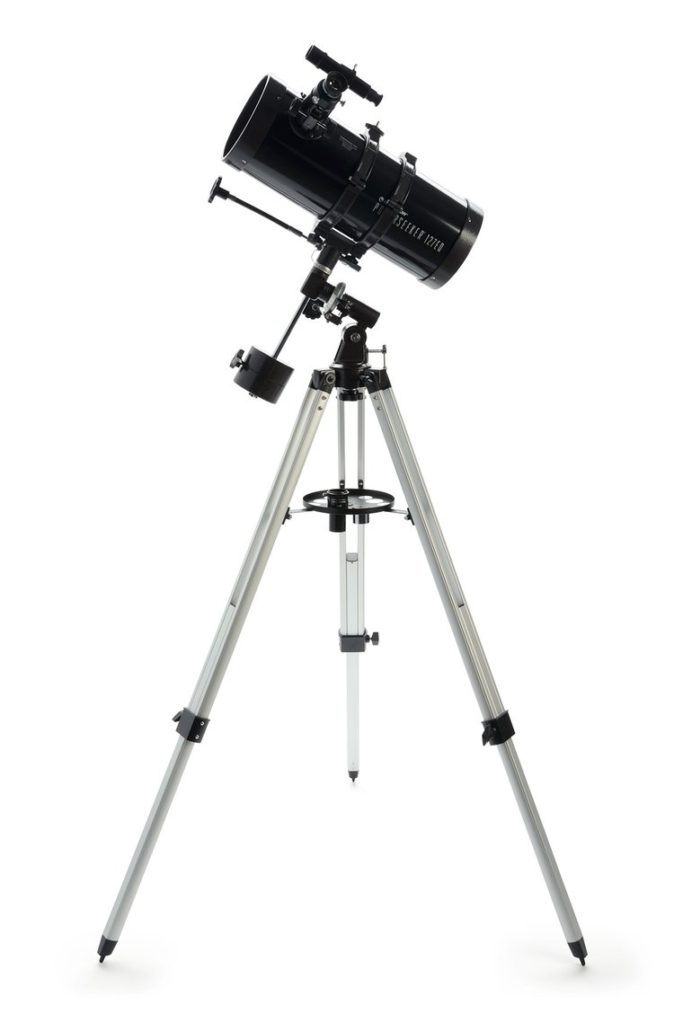
The PowerSeeker 127EQ is highly portable and one of the best telescopes to see Jupiter. You could easily fit this telescope and tripod in the trunk of a car and still have room for your other equipment, or maybe a late night picnic.
Additionally, you receive a copy of Starry Night astronomy software with a database of over 10,000 celestial objects.
Considering the telescope’s low price, compromises had to be made, and one such compromise is the use of a spherical mirror rather than a parabolic mirror.
Optical aberrations tend to be more common with spherical mirrors. This telescope does, however, feature an erect image diagonal for the right way up images, which prevents some aberration.
This telescope comes with an Equatorial mount, designed for astronomy telescopes. Included are two manual slow-motion controls, these allow for smoother tracking of objects as they pass across the night sky.
The tripod is made of aluminum, although lightweight, it is robust, solid and also comes with a very handy accessory tray which lets you keep extra eyepieces and T-rings for a camera, close to hand.
Pros:
- Solid build quality
- Stable mount
- Comes with a 3x Barlow lens
Cons:
- Spherical mirror leads to some amount of aberrations
- Occasional collimation of the mirrors required
Best Telescope For Astrophotography
Sky-Watcher ProED
- Type: Apochromatic Refractor
- Aperture: 100 mm(3.9″)
- Focal length: 900mm
- Focal Ratio: f/9
- Mount: Vixen Style
- Eyepiece: 20mm, 5mm
- Magnification: 50x, 250x
- Weight: 8.4 lbs.(3.8 kg)
- Our Rating: 9.4/10
Prices pulled from the Amazon Product Advertising API on:
Product prices and availability are accurate as of the date/time indicated and are subject to change. Any price and availability information displayed on [relevant Amazon Site(s), as applicable] at the time of purchase will apply to the purchase of this product.
The Sky-Watcher ProED 100mm f/9 Doublet APO Refractor features a doublet apochromatic lens system with Extra-low Dispersion glass and Sky-Watcher’s proprietary photon anti-rejection Metallic High-Transmission Coatings on all air-to-glass optical surfaces.
This combination of glass, lenses, and coatings virtually eliminates chromatic aberrations for clear and bright high-contrast images with true color rendition.
This is a versatile optical tube assembly that is well suited for wide-field astronomical observation of prominent nebulae, star clusters and galaxies, or can be used as an astrograph for sky photography, a terrestrial spotting scope or telephoto lens.
The scope features an ED Schott glass, which is rare in many professional telescopes.
This Doublet APO Refractor Telescope comes with a 2” Crayford-style focuser which is one of the best focusers in telescopes as it is a Dual-speed one. A 1.25-inch adapter is also included along with it.
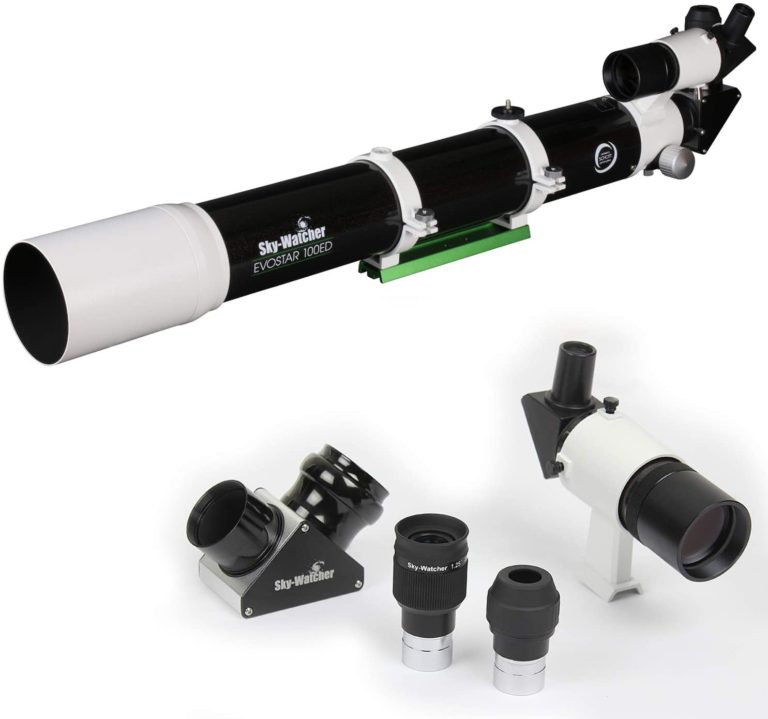
The Sky-Watcher ProED is one of the best apo refractor telescopes to see and photograph Jupiter and other planets and it comes with several accessories to help you get observing faster and easier. First, are 2 long eye relief eyepieces that produce 30x and 120x magnification and a 90° star diagonal for more comfortable viewing.
A large 8×50 erect-image finderscope to make finding your celestial objects faster and easier. The finderscope is fully-multicoated to ensure maximum brightness and contrast.
Additionally, Sky-Watcher provides a foam-lined aluminum carrying case to safely store and transport the OTA.
The Sky-Watcher ED-APO design assures virtual elimination of secondary, residual false color normally present in two-element achromatic lens designs using Crown and Flint glass
With ED APO Sky-Watcher refractor telescope, you’ll experience breathtaking high contrast views that have no equal to planetary and deep-space objects against pitch black skies.
The Sky-Watcher Pro Apochromatic Telescope has enough high contrast/high resolution optical performance to let you use it on an alt-azimuth or equatorial mount.
It’s only 6.6 lbs., lightweight and doesn’t require a big and expensive mount, so it’s easy to afford and easy to take out and set up for observing on a moment’s notice.
The Sky-Watcher ED-APO features a contrast-enhancing internal light baffles in the tube and focuser drawtube and a specially darkened tube interior providing dark sky backgrounds and high terrestrial contrast.
This apochromatic telescope comes with a dew shield which slows the formation of dew on the lens in cold weather to extend your undisturbed observing time.
Pros:
- Best for professionals
- Maximum magnification
- Accurate in focus
- 9×50 RA viewfinder
- Two-inch dielectric diagonal
Cons:
- Focuser slips with heavy eyepieces
- Flimsy case
Best To See Jupiter’s Moons
Celestron – NexStar 127SLT
- Type: Schmidt-Cassegrain
- Aperture: 127mm (5″)
- Focal length: 1500mm
- Focal Ratio: f/12
- Mount: Computerized Alt-az
- Eyepiece: 25mm, 9mm
- Magnification: 60x, 167x
- Weight: 18.0 lbs.(8.2 kg)
- Our Rating: 9.6/10
Prices pulled from the Amazon Product Advertising API on:
Product prices and availability are accurate as of the date/time indicated and are subject to change. Any price and availability information displayed on [relevant Amazon Site(s), as applicable] at the time of purchase will apply to the purchase of this product.
The Celestron NexStar 127SLT is an entry-level GoTo telescope designed for anyone looking for a reliable telescope with which to enjoy the nighttime sky.
Read Celestron NexStar 127SLT’s full review.
The telescope features a 127mm aperture and Celestron’s SkyAlign technology, this telescope offers consumers good views. In addition, the telescope’s single fork arm and simple design make it easy to set up and use.
The scope’s focal length is 1500mm, and it has a focal ratio of f/12. As far as eyepieces are concerned, each Celestron NexStar 127 SLT telescope comes with a 25mm eyepiece and a 9mm eyepiece, having a maximum magnification of 167x with the default 9 mm eyepiece.
The Celestron NexStar 127 SLT telescope stands on top of a motorized Altazimuth mount, which can be controlled via the provided digital hand controller.
Alternatively, the mount can be hooked to a computer for increased precision.
With preassembled, adjustable stainless steel tripods, and quick release fork arms and tubes, the NexStar 127 SLT telescope can be set up in a matter of minutes with no tools required.
The 127 SLT with its large aperture is great for viewing the surface of the moon, phases of Venus, rings of Saturn or Jupiter and its four largest moons, and other deep-space objects.
The Celestron NexStar 127SLT is also the best GoTo telescope for astroimaging Jupiter.
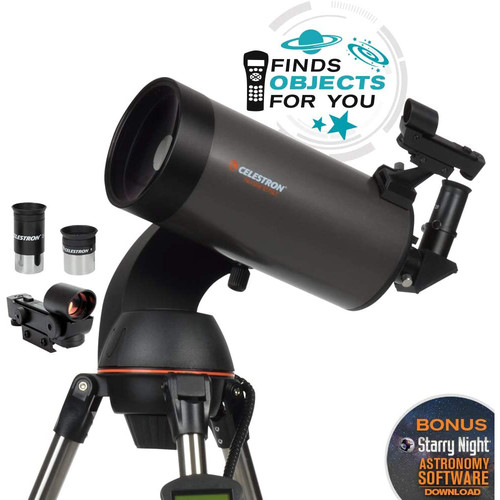
The Celestron NexStar GoTo mounts are powered by eight AA user-supplied batteries, or an optional AC adapter, making them perfect as a travel telescope.
With Celestron’s SkyAlign Technology, aligning your telescope is fast and easy. Simply input the date, time and location (the CPC models have built-in GPS that does this for you) and then align the telescope to three bright stars of your choosing.
You do not need to know the names of the stars, you can even pick the moon or bright planets. The NexStar computer system will automatically figure out which stars were chosen and then align the telescope.
The 127SLT’s diagonal is a prism, and a nice one at that – unlike the cheap diagonals supplied with many entry-level scopes which are cheap mirrors that aren’t very flat, which tend to offer dim and fuzzier images.
Pros:
- Super optical construction
- Very easy to operate with
- Compact and portable design
- Included needed additional accessories
- Suitable for lunar/planetary astrophotography
Cons:
- 8 AA batteries required but not included
- Tripod can be more stable
Best Telescope To See Jupiter - Buying Guide
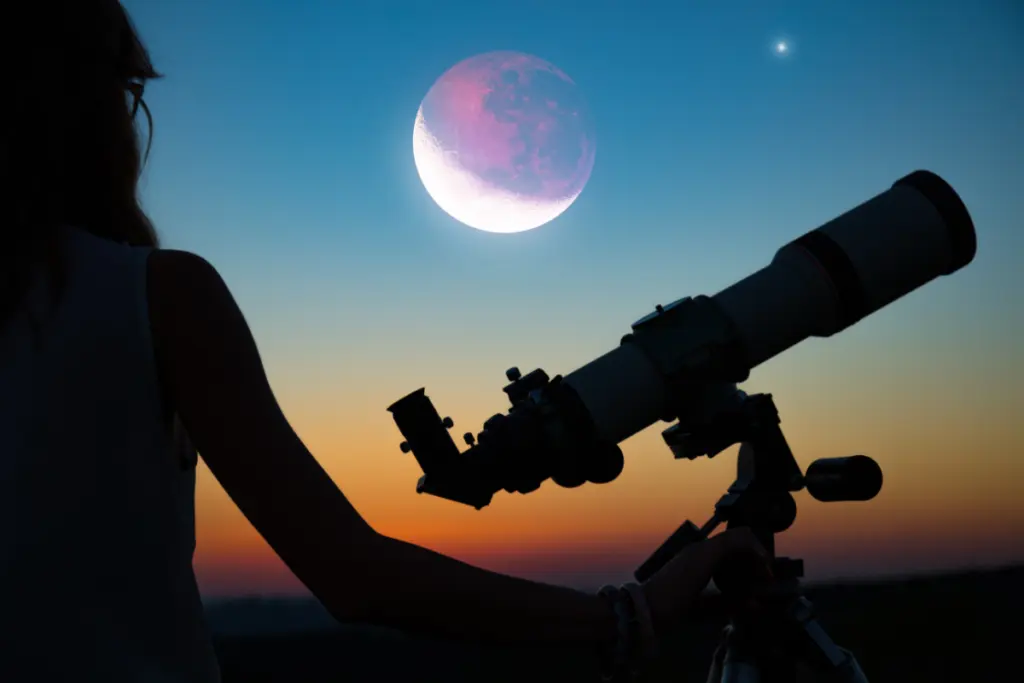
For a breathtaking planetary viewing experience every time, it is important to make sure you’re purchasing a quality product – not something you’ll find at most department-stores.
The telescope you want has two essentials: high-quality optics and a steady, smoothly working mount. You may also want the telescope to be nice and large, but don’t forget portability and convenience.
Features To Consider When Choosing A Good Telescope To See Jupiter
Aperture
The most important aspect of any telescope is its aperture, the diameter of its main optical component. A scope’s aperture determines both its light-gathering ability and its resolving power.
The aperture of a telescope is the diameter of the light collecting region, assuming that the light collecting region has a circular geometry . For an optical instrument, the aperture is the diameter of the objective lens (refracting telescope) or the primary mirror (reflecting telescope).
The larger the aperture, the more light the telescope can gather, and the fainter the limiting magnitude of the instrument. The field of view of the telescope decreases as the aperture increases, but the resolving power increases.
Focal Ratio
Focal ratio is the focal length divided by the objective diameter. A long focal ratio implies higher magnification and narrower field of view with a given eyepiece, which is great for observing the moon and planets and double stars.
For such objects, a focal ratio of f/10 or more is ideal. But if you want to see wide views of star clusters, galaxies, and the Milky Way through your telescope, then a lower focal ratio is better. You get less magnification, but you see more of the sky. Wide field telescopes have a focal ratio of f/7 or less.
Focal Length
The focal length is simply the effective distance from the lens or mirror to the focal point, where an eyepiece or camera would go.
Focal length is useful for two reasons: it’s the major determinant of useful magnification (which we’ll get onto in a moment) and it gives you a rough idea of what sort of field of view you can expect.
Smaller focal lengths deliver wider fields, so lean towards being better suited to observing large swathes of the night sky and for star hopping, while longer focal lengths offer narrower fields – perfect for planetary disc close-ups – and tend to allow you to use eyepieces with longer eye relief.
Accessories
A telescope is not a solitary object, and it needs many accessories to reach its full potential and unleash its A-game.
Mount & Base Support
First of all, mount and base support are the two most essential things required for the safe-keeping and proper functioning of a telescope.
Base support connects the actual telescope to the ground and creates a steady base. A mount is also an accessory that is vital to keep the telescope at its place for a peaceful trip on the outlook of space.
Tripod Stand
It is also crucial to determine the place where you plan on setting the telescope for good and choose the base support according to that spot, such as a window or floor. A tripod stand is the second most vital accessory that accompanies a telescope.
It is required to give length to the telescope so you can bring up the device to an appropriate height for a comfortable posture.
Apart from your comfort, a tripod stand also helps in keeping this delicate device steady on its grounds, so you don’t lose hundreds of dollars due to a slight nudge or a powerful breeze.
Carrying Bag
We discussed how important is portability when it comes to telescopes. It is one thing when a telescope can be converted into a compact device that can easily accompany you on your quest to view the Universe that exists beyond the limits of the naked eye.
A carrying bag specifically designed to hold up the telescope and all of its accessories safely is a lot of relief and a safe way to manage your device neatly.
Extra Eyepieces
Other accessories like an extra eyepiece or extra magnification lenses are also present, but they are not as essential as the ones mentioned above. But if you do manage to find a good deal where such accessories are also included in the package, then you can enjoy the majestic view with your special buddy simultaneously. As they say, the more, the merrier!
Conclusion
Our top pick for the best telescope to see Jupiter for beginners is the Celestron – AstroMaster 114EQ.The Celestron AstroMaster 114 EQ reflector telescope is a great beginner telescope for an adult or older child. It’s 4.5” mirror will provide clear and bright images of the Moon, the planets, and dozens of deep-sky objects like the Orion Nebula, the Andromeda Galaxy, the great star cluster in Hercules, and much more.
The AstroMaster equatorial mount is easy to set up and requires no tools to do so. Unlike a simple alt-azimuth mount, an equatorial mount will allow your telescope to track objects as they move across the sky throughout the night.
Our next pick for the best budget telescope to see Jupiter is the Celestron – PowerSeeker 70EQ.
Designed for intermediate users, Celestron‘s PowerSeeker 70mm f/10 EQ Refractor Telescope is intended to take astronomic observation to the next level by providing a complete set up for viewing the Moon and planets, and brighter deep-sky objects like star clusters and galaxies.
Our pick for the best computerized telescope to see Jupiter is the Celestron – NexStar 6SE.
Celestron‘s NexStar 6SE 150mm f/10 Schmidt-Cassegrain GoTo Telescope is a powerful, portable, and user-friendly Schmidt-Cassegrain-style scope that can be used for observing everything from the Moon and planets to deep-sky objects like stars, galaxies, and nebulae
Written by:

Chandrashekhara Rao
I grew up in a rural community with a dark sky, and that is where I learned to appreciate planets and stars at an early age. I have been fascinated with all things astronomical since I was a kid and started with a cheap-and-cheerful 60mm refractor on a wobbly tripod.
ABOUT US
We are a team of active amateur astronomers, here to help you with all your astronomy and science related needs – this is anything, from reviewing the latest telescopes to be released to talking about gravity and neurons. The Big Bang Optics was started because of our love for astronomy and to help others like us find the best telescope and accessories.
LEGAL DISCLAIMER
The Big Bang Optics is a participant in the Amazon Services LLC Associates Program, an affiliate advertising program designed to provide a means for sites to earn advertising fees by advertising and linking to Amazon.com. The Big Bang Optics also participates in affiliate programs with Clickbank and other sites. The Big Bang Optics is compensated for referring traffic and business to these companies.



